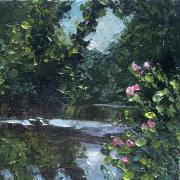Being invited to display at the Chelsea Flower Show is the highest honour for a gardener. Pat Ashworth finds out how Derbyshire's florist to Chatsworth House has made it to the very top
There can’t be many boys who get a greenhouse for their eleventh birthday, but that’s what Jonathan Moseley wanted and that’s what he got: an eight foot by six foot structure dedicated to growing plants and flowers only and a strictly no go area for his father’s tomatoes. He supplied the local village shop from it, prepared catalogues for his parents to distribute amongst their friends and by the time he left school, had earned enough money from plant sales to buy his first car.
Money was never the driving factor, though. His early love of flowers came from his grandparents, who put him in touch with nature and always took him to see the first snowdrops, the first primroses, the first bluebells, the first marsh marigolds. They gave him his first piece of garden too, his very own territory. ‘My granddad was a great gardener. He taught me the love of growing, taking cuttings, gathering seeds, germinating things,’ he says with pleasure. ‘Then when I was old enough, I used to go to the shows with him. In plants there is perfection, and I was enchanted and intrigued watching these quite elderly gentlemen tweaking their chrysanthemum and dahlia blooms to get them looking perfect.’
He started showing flowering plants himself and to win prizes but that wasn’t enough. He wanted a cup and realised that to get a trophy, you had to do ‘something that got you the most points in the overall show. They always had a class called Domestic Section, where you could do a vase or basket of flowers, a corsage or a buttonhole, so I started to make those. And one year I did manage to get the cup – I was about twelve at the time. I was going for gold from then on!’ He entered so many things that an uncle with a van had to come and pick them all up. It was a good learning curve, he says: it taught him to ‘get to that level of perfection that’s required and also to work against the clock to get things ready.’
The boy’s life changed when an artistic elderly friend of his mother’s watched him working in the garden and suggested he might be good with flower arranging. ‘She rolled up with a bag of bits and bobs from a flower course she’d done. That’s when I found about the green stuff, the floral foam, the oasis... That was really a quite revolutionary moment, part of my staple diet now, though I never thought I’d get through quite such copious amounts,’ he says with his big smile.
And then it was a Saturday job at the flower shop in the neighbouring village of Dinnington, flower courses and, when he was about 13, the discovery of flower clubs and the National Association of Flower Arrangement Societies (NAFAS). ‘I was the youngest, still am, I think!’ he reflects. ‘I suppose I was a bit of a local character. I used to watch these people demonstrate and saw their skills. They said "You’ll be up there one day, you’ll see." I was so shy as a kid and didn’t dare stand in front of those people and do something. Little did I know that that would be my destiny.’
Nor could he have dreamed that he would end up working at Chatsworth, a place he describes as utterly inspirational. Living in the area, it’s always been in his blood, he says, the place for a Sunday run out with the family and for awestruck sorties through the gardens with his granddad. He continued visiting throughout his developing career: the four innovative years at a Rotherham garden centre that followed his degree in Ancient History, and the subsequent teaching and demonstrating qualifications and experience that led him through the ranks to become the chairman of NAFAS, a role he has undertaken for the past four years. ‘I’ve been teaching now for 20 years,’ he says happily, ‘and I’m thrilled that so many people have been given the passion that I’ve got. It’s like a little legacy that lives on in other people.’
The Chatsworth connection followed the success of a flower festival that Jonathan, as one of a NAFAS team of three, designed and put on at the House. He did a demonstration in the Victorian theatre during the five-day festival, and says there is no other word than ‘gobsmacked’ to describe his reaction to the invitation to discuss future flower events, including an annual festival, Florabundance, which followed. I’m curious to know how on earth you make flowers stand out in the context of the existing splendours of a place like Chatsworth, and Jonathan acknowledges, ‘You do so often feel you’re gilding the lily, because Chatsworth is so ornate and some of the rooms are terribly opulent. It’s hard for something which is often quite subtle, as flowers in their natural state are, to compete against that level of splendour.
‘You are always conscious that you’re working flowers against, say, a Rembrandt behind it – how can anything a mere mortal create compete against that priceless treasure? It’s hard to offset your display against the great masters, but we try to work sympathetically or sometimes work against it so that you have the shock factor – sometimes flowers can shock just by the colour and variety you use. Or it’s the fragrance sometimes. One thing that worked particularly well at Florabundance one year was a bare tree that we took up to the Mercury landing at the top of the Painted Hall.
‘It was a huge, naked tree that had died a natural death, and the gardeners managed to get it inside. Hanging from it were all different varieties of apples and then coloured glass and bright shocking pink and orange gerberas. It looked mesmerising, really glowing and radiating these strong colours as you went up the stairs and caught all the different vistas.’
Quirky installations to catch the eye on the constantly changing and inspiring visitor route have included a cast iron bath in the Grotto, frothing and bubbling over with gypsophila. Most of all, he enjoys dressing the sumptuous table in the Great Dining Room, though he admits to ‘heart-stopping’ moments when he has to lean across the priceless china and glass. ‘You’re placing something and it’s, "Please, God, don’t let me slip." Sometimes you have to delegate it to a member of staff... But it’s just fabulous. I’m in the fourth year of it now and I love it because you are surrounded by so much inspiration.
‘The ultimate is having picking rights from the grounds, thinking, I’d love a bit of that for this arrangement... I don’t abuse it in any way but just strategically pick certain pieces. People love it when we’re doing the day workshops such as the Christmas one. If they know they’ve got some Chatsworth greenery on their door, it’s their absolute thrill – a real statement piece and something most people are just so proud of, because Chatsworth as a brand is world-renowned. Everything is done to the highest standards, so for me to be linked with that is a huge, huge honour.’
Easter workshops are a new venture for this year, at a time when people are following trends in places like Holland and Germany and dressing and decorating their homes in a much bigger way to celebrate the festival. ‘It will be designs themed for the home, so that people will be inspired to have a bash. At the end they’ll take away two lovely designs, ready made,’ Jonathan says with enthusiasm, adding, ‘I do think it keeps people in touch with their creative side. So many who come on the workshops are not flower enthusiasts but just want to do something creatively, maybe as a special gift, or who want a day off from a high-powered job to do something completely different.
‘And it’s so lovely to see them really apprehensive at the beginning and then watch their creativity bloom. We’ve never had anyone over the years who hasn’t left with something that wasn’t completely wonderful. They always say, "Mine will look nothing like that" but they do and at the end, when they’re all together, it’s hard to pick mine. Because flowers are already there, we’re selecting from a colour palette. You’ve got all the forms and shapes, so part of the battle is done for you. If you can create by selecting and mixing those colours together, it will never look completely wrong because nature has already done it for you. And if you look at nature itself, anything works – clashing colours together, large against minute, some very textured and very bland detail... put it all together in a hedgerow or woodland and it works. That’s a huge achievement.’
Spring is the nicest time, he says with conviction: the flowers so welcome after the gloom and doom of winter, and special, too, because they are so transitory. And if there’s something that has to be grown specially, Chatsworth’s head gardener, Steve Porter, will grow it in the hothouses, cottage garden or cuttings garden, ready for Jonathan and his team of helpers to pick. They include many of the ladies who have been on his courses and workshops over the years and regard just the luxury of cutting flowers at Chatsworth a real treat – after all, Jonathan says, who hasn’t wandered around the gardens with itchy fingers?
His own garden is a third of an acre, just big enough to keep on top of and packed with herbaceous plants from which to take cuttings and shrubs. He does demonstrations throughout the year, so tries to grow things he can use in his designs that people are less familiar with, like a new variety of shrub, together with the cottage garden flowers people love – foxgloves, lupins, hollyhocks, ‘tall elegant things evocative of our childhoods,’ he says, also expressing a preference for growing things that can’t be purchased.
And simplicity is everything in his own home: he’s wandered round his garden today and picked a few hellebore heads to float in a shallow bowl of water, ‘not ostentatious, just simple blooms,’ he says, observing, ‘The heads hang down so you don’t often get chance to look down on them. So they’re looking up to us and you see the beauty of the petals, so gorgeous. To me, it’s like looking into a sweetshop with all those tempting, alluring colours.’
The stand he has been invited to design for NAFAS at Chelsea is 20 foot square, a magnitude he describes as awe-inspiring. It will be in the new floral pavilion and will take over 3,000 man-hours to put together: a build-up which starts on a Wednesday and continues for five days until the press day on Monday 21st May. It’s a massive logistical exercise, technically as well as horticulturally challenging, and Jonathan’s team of eight will be working literally from dawn until dusk. His design is inspired by the work of the impressionist painter, Claude Monet, and depicts his series of waterlily paintings, an obsession that led him to use the variety of flowers so many times.
Jonathan, who has had the pleasure of visiting Monet’s garden at Giverny, says in wonder, ‘He employed a gardener to go out on a boat every morning and just perfect the water lilies in preparation for going out at first light to paint. He was absolutely obsessed by these flowers. I find it quite remarkable how all the canvases are of the same blue but so different. He wasn’t able to see the more subtle colours as his sight deteriorated so his use of colour became stronger and he started to grow things that had more primary stronger colours.’
Water lilies are almost unobtainable as a cut flower and so Jonathan and his team will be crafting them from other cut flowers – using over 2,500 stems. He acknowledges, ‘It’s going to be quite a challenging stand. We’re harnessing our creativity. We want people to look at it and recognise the quintessential Monet, the bridge with the sea of waterliles underneath it, but then underneath the stand we’re going to have different Perspex frames made and we’re going to create these living canvases of waterlily paintings out of fresh plants. Flower arranging is an art and we’re pushing the bounds a bit as to how we use flowers in a craft-driven form.’
Glass droplets with suspended flowers will enhance the effect of misty water. ‘That in itself is a massive thing to do,’ Jonathan admits of the scaffolding tower that has to be erected and dismantled on site. ‘It’s a piece of art that will never compete against the mastery of Claude Monet but it is living art, which gives it a different slant. Flowers are often overlooked if they’re just pretty. People stop and it arrests attention.
‘Our art is transitory but it’s like sculpture because we are working in a three-dimensional space. If I do nothing else, if I can just make half those people who visit Chelsea grow something that we’ve got on our stand, buy a bunch of something or a small arrangement and hopefully join a flower club, I’ll be happy, I do think the flower club movement is one of Britain’s best kept secrets, a victim of a stereotype which doesn’t really exist.’
Designing the Chelsea stand is ‘the pinnacle of my career so far, together with working at Chatsworth. The two together are huge time commitments but wonderful places to work, the cream of the horticultural and floral worlds. It’s a great honour for me,’ he says, and really means it. He’s had to get used to even more limelight than usual: a BBC film crew followed him and his team through the preparations for Florabundance last year, covering every minute stage from soaking the floral foam to trundling the barrowloads of thousands of flowers from the Chatsworth gardens. Many of his helpers have been coming for years and are floral designers in their own right. ‘They were all on their best behaviour, and making me laugh as well,’ he says.
Almost every aspect of his life is linked to flowers in some way: his garden; the work he does with floral suppliers, Country B; his role with NAFAS. ‘I do pretty much live and breathe flowers. It’s lovely,’ he says. ‘It’s not an easy world because it’s hard work, but you are around beauty. If I’m away from that, in a very utilitarian location and there’s no green or prettiness, I do feel like I’m in a hostile environment. I do think that to be around flowers is within me, something that will always be there. I really can’t imagine life without it.’
Jonathan is staging Easter themed floral workshops at Chatsworth on 2nd and 3rd April; other workshops and demonstrations during the year: spring blooms 4th-8th May alongside the tulip and spring flower festival; Summer Wedding theme 20th-21st June; autumn 22nd-25th September; Christmas 15th-16th, 29th-30th November. Florabundance will take place from 21st-25th September this year, with a celebration of dahlias and autumn flowers. Details at www.chatsworth.org. RHS Chelsea Flower Show takes place 22nd-26th May. Tickets www.rhs.org.uk or tel: 0844 338 7506.


























